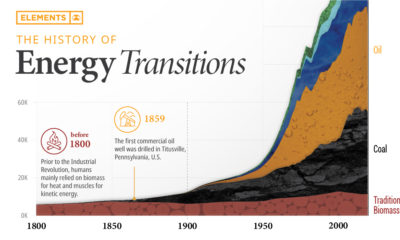Misc
Seven Man-Made Engineering Wonders of the Ancient World
Take a look around any major city today, and it’s evident that humans are pretty incredible builders.
We can create suspension bridges that span the widest rivers, or sleek skyscrapers that are over 1,000 m (3,300 ft) high. Even further, we can design these complex structures with extreme amounts of precision and consistency.
But while there is no shortage of modern engineering accomplishments to marvel at, it’s true that our ancestors also made impressive feats in the field of civil engineering. Ancient cultures were able to do things that still baffle people today, such as constructing majestic pyramids, erecting flawless walls out of huge boulders, or carving out multiple underground, monolithic churches from a rocky ridge.
Engineering Feats of the Ancient World
Today’s infographic comes to us from Norwich University, and it showcases details on seven civil engineering wonders from the Ancient world.
Note: Some ancient wonders, like the Great Pyramid of Giza, Roman aqueducts, and the Great Wall of China can be found on a previous infographic that counts them among the 10 Most Impressive Civil Engineering Projects of All Time

Ancient engineers and architects were able to pull off some pretty impressive feats.
Let’s take a detailed look at the seven listed here, including the aspects that continue to baffle modern engineers today.
Ancient Man-Made Wonders
1. Saksaywaman, Peru (16th century)
Imagine three giant stone walls made of giant boulders that all fit together perfectly, like puzzle pieces. The Incas managed to build these outside of Cusco, using boulders up to 120 tons in size. No one knows how they moved them from a quarry 3 km (2 miles) away to the site – and even more perplexing is how flawless they fit together.
2. Leshan Giant Buddha, China (803 CE)
This is the world’s largest carved stone Buddha statue in the world, and it stands 232 tall in China. The carved hair of the statue even has a hidden, built-in drainage system that displaces rainwater to protect it from damage.
3. Chand Baori, India (10th century)
This one of the world’s deepest stepwells, and it provides water to a hot, arid region before modern plumbing was possible. The stairs weave 3,500 steps, or about 13 stories, down into the depths where carved stones collect rainwater.
4. Underground Churches of Lalibela, Ethiopia (12th and 13th centuries)
These 11 underground churches were carved out of rock from the top-down. They are also connected, using a complex system of drainage ditches, tunnels, and subterranean passageways.
5. Teotihuacan, Mexico (450 CE peak)
At its peak, this ancient urban city sprawled 22 miles (35 km) with over 200,000 inhabitants. Not only does it have some of the largest pyramidal structures on the planet, but it also has many other unique traits, such as being aligned with celestial, geographic, and geodetic points of significance.
6. El Mirador, Guatemala (300 BCE)
This is the largest of five known Pre-Classical Mayan cities and it contains the world’s largest pyramid by volume. A total of 15 million man-days of labor were needed to create the iconic temple, named La Danta.
7. The Lost City of Mohenjo Daro, Pakistan (2500 BCE)
This city is over 4,500 years old, and it was unknown to modern people until 1921. It housed up to 35,000 people, and contained complex water and sewage system on a grid plan. Mohenjo Daro is regarded today as one of the most important archaeological finds, unveiling details on the Indus Valley people – one of the most widespread and mysterious civilizations of the early Ancient era.
United States
Charted: What Southeast Asia Thinks About China & the U.S.
A significant share of respondents from an ASEAN-focused survey are not happy about rising American and Chinese influence in the region.

What Southeast Asia Thinks About China & the U.S.
This was originally posted on our Voronoi app. Download the app for free on iOS or Android and discover incredible data-driven charts from a variety of trusted sources.
This chart visualizes the results of a 2024 survey conducted by the ASEAN Studies Centre at the ISEAS-Yusof Ishak Institute. Nearly 2,000 respondents were asked if they were worried or welcoming of rising Chinese and American geopolitical influence in their country.
The countries surveyed all belong to the Association of Southeast Asian Nations (ASEAN), a political and economic union of 10 states in Southeast Asia.
Feelings Towards China
On average, a significant share of respondents from all 10 countries are worried about rising influence from both the U.S. and China.
However, overall skepticism is higher for China, at 74% (versus 59% for U.S.).
| Country | Worried About Growing 🇨🇳 Influence | Welcome Growing 🇨🇳 Influence |
|---|---|---|
| 🇧🇳 Brunei | 58% | 42% |
| 🇰🇭 Cambodia | 66% | 34% |
| 🇮🇩 Indonesia | 57% | 43% |
| 🇱🇦 Laos | 68% | 32% |
| 🇲🇾 Malaysia | 56% | 44% |
| 🇲🇲 Myanmar | 95% | 5% |
| 🇵🇭 Philippines | 81% | 19% |
| 🇸🇬 Singapore | 74% | 26% |
| 🇹🇭 Thailand | 84% | 16% |
| 🇻🇳 Vietnam | 96% | 4% |
| Average | 74% | 27% |
The recently-cooled but still active territorial concerns over the South China Sea may play a significant role in these responses, especially in countries which are also claimants over the sea.
For example, in Vietnam over 95% of respondents said they were worried about China’s growing influence.
Feelings Towards America
Conversely, rising American influence is welcomed in two countries with competing claims in the South China Sea, the Philippines (69%) and Vietnam (55%).
| Country | Worried About Growing 🇺🇸 Influence | Welcome Growing 🇺🇸 Influence |
|---|---|---|
| 🇧🇳 Brunei | 73% | 27% |
| 🇰🇭 Cambodia | 58% | 42% |
| 🇮🇩 Indonesia | 73% | 27% |
| 🇱🇦 Laos | 79% | 21% |
| 🇲🇾 Malaysia | 68% | 32% |
| 🇲🇲 Myanmar | 45% | 55% |
| 🇵🇭 Philippines | 32% | 69% |
| 🇸🇬 Singapore | 37% | 63% |
| 🇹🇭 Thailand | 80% | 20% |
| 🇻🇳 Vietnam | 45% | 55% |
| Average | 59% | 41% |
Despite this, on a regional average, more respondents worry about growing American influence (59%) than they welcome it (41%).
Interestingly, it seems almost every ASEAN nation has a clear preference for one superpower over the other.
The only exception is Thailand, where those surveyed were not a fan of either option, with 84% worried about China, and 80% worried about the U.S.
-

 Culture7 days ago
Culture7 days agoThe World’s Top Media Franchises by All-Time Revenue
-

 Science2 weeks ago
Science2 weeks agoVisualizing the Average Lifespans of Mammals
-

 Brands2 weeks ago
Brands2 weeks agoHow Tech Logos Have Evolved Over Time
-

 Energy2 weeks ago
Energy2 weeks agoRanked: The Top 10 EV Battery Manufacturers in 2023
-

 Countries2 weeks ago
Countries2 weeks agoCountries With the Largest Happiness Gains Since 2010
-

 Economy2 weeks ago
Economy2 weeks agoVC+: Get Our Key Takeaways From the IMF’s World Economic Outlook
-

 Demographics2 weeks ago
Demographics2 weeks agoThe Countries That Have Become Sadder Since 2010
-

 Money2 weeks ago
Money2 weeks agoCharted: Who Has Savings in This Economy?














